We continue to develop an adventure platform for Russians: interface features and summer preferences
A few months ago we started the adventure search platform - these are tours, only very unusual, there are short ones, there are for a couple of weeks, there is something that will be remembered for a lifetime. Our main problem: when there were about 350 adventures, we drowned in sorting. The situation was tense until there were about 800 options. For example, here is the “extreme” tag. Someone thinks that riding horses uphill is extreme (because you need insurance above the sport level), and polar explorers, mountain rescuers and teachers of driving on buggies and rifle training from Chechnya mockingly laugh at them.
Here is the first form, it was designed for those who already know what they are looking for. As it turned out, we practically did not have such users:

')
Here we have added a free search field and our editorial collections. That didn't help much.
In parallel, we tested this form:

People still used the adventure catalog, and used the form only to find something they had already seen. On the other hand, we received statistics on its use and understood what people are looking for, when they do not understand what to look for. Since in the Russian market, such a problem, in principle, has not yet been solved, it was about what we need. Then we did a little research: we tested all this on people who are not aware of the project.
While postponing the hypothesis of adding tags for rework:

Then it turned out that people do not really understand what an adventure is. Need to see the range to look for. That is, this is a search that is possible only after viewing the catalog.
If a person asks what is adventure for him, he remembers only things already known. “I want to dive”, “And I want a gastrotur” - that is what is known. Almost everyone wanted to ride horses, but no one was looking for them.
Again, they removed everything that the users do not use, and began to collect statistics. With tens of thousands of hosts per day on the portal, this is a rather cynical but effective way to refine the UI.

The “hamburger” was opened not by type of adventure, but by the desired result:
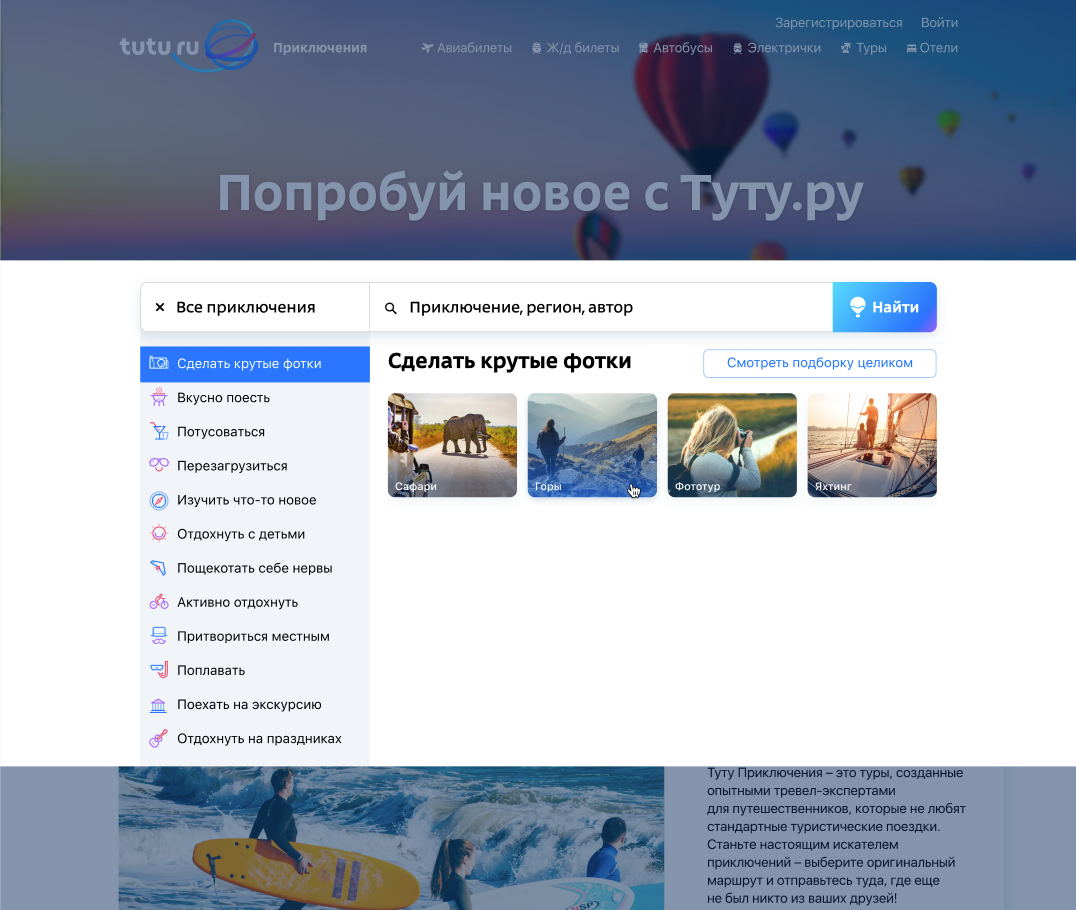
And they made a full sadjest, which, depending on the person’s request, offers him several ways at once to search for adventures through the subject, region, organizer or selection (script):
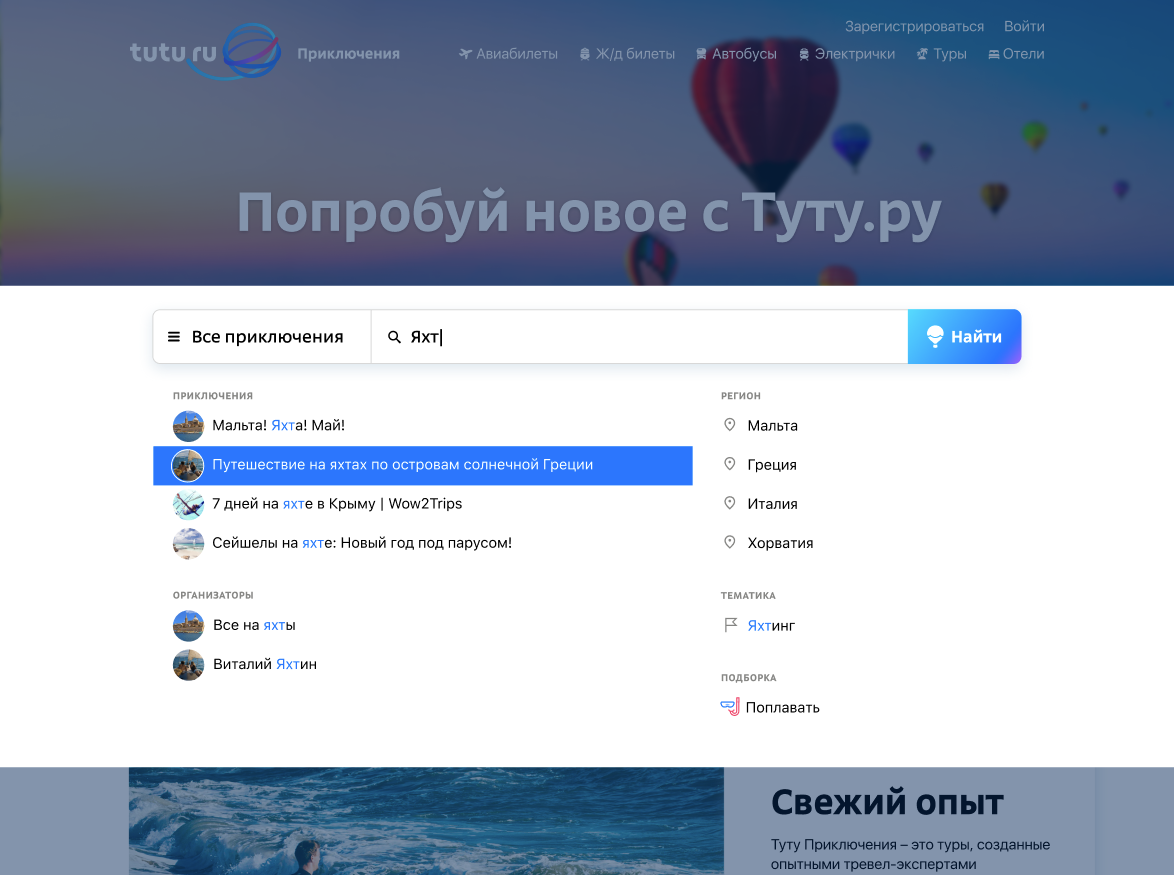
Here were two important things at once. First, we had to look for “human” names for such things as “ethnotour” or “gastrotur”, because the terms too few people knew. Secondly, clustered themes of adventure to the main tasks in them. It is clear that this is a simplification, and some very unusual things will be left behind, and some will fall into several categories at once, but this is still the best idea of the workers.
At the same time, they tried to make an adviser like a telegram-bot for regular tours (only online), here are the details . It was assumed that if this interface works, then we can apply it to the adventure. But there the task is more understandable - emulation of communication with the manager of the travel agency, which many people lack on the site.
With adventure, we are closer to the usual search. The main thing is top-level ideas that can be done. In the tours, the question of fine-tuning, despite the fact that you know what you want and what you can. With top-level views, we rested in the cultural code. Here the words "relax" for a resident of Siberia often mean a beach holiday, and for a resident of Cyprus can mean mountains. And so on. It's like a story with a cup and a mug: when the values for the dictionary were updated, there were different versions in different regions. Somewhere mug - only metal. Somewhere a cup - only with a saucer. Somewhere a cup is in the kitchen, and a cup is in a sideboard. Somewhere they differ in thickness. At the same time, looking at the subject, we can quite uniquely determine what it is. With high-level search abstractions, the same effect had to be achieved.
We are in the process.
During development, small IT-tasks were crawling from different angles, which individually looked ridiculous, but together gave rise to an already complex system. For example, filter by price. That is, you need to bring everything to the same equivalent (apparently, ruble), taking into account the current exchange rate of different currencies (because adventures are in different countries). But to show the price in rubles is not very correct, because the courses can change every 15 minutes. Can be solved? Can. Simply? Yes, if you don’t know that there are hundreds of such questions.
As a result, the user's path now looks like this: he looks at an average of up to 15 adventures without sorting in order to understand what is possible in this world at all. Then he begins to clean up what he definitely does not want. And then oriented in the form and starts to play.
Another important discovery was that search works better not with parameters and descriptions, but with photos. It seems that for us a photo on Instagram is already a more natural result of travel than rest in itself.

A trip to the Day of the Dead in Mexico just needs pictures.
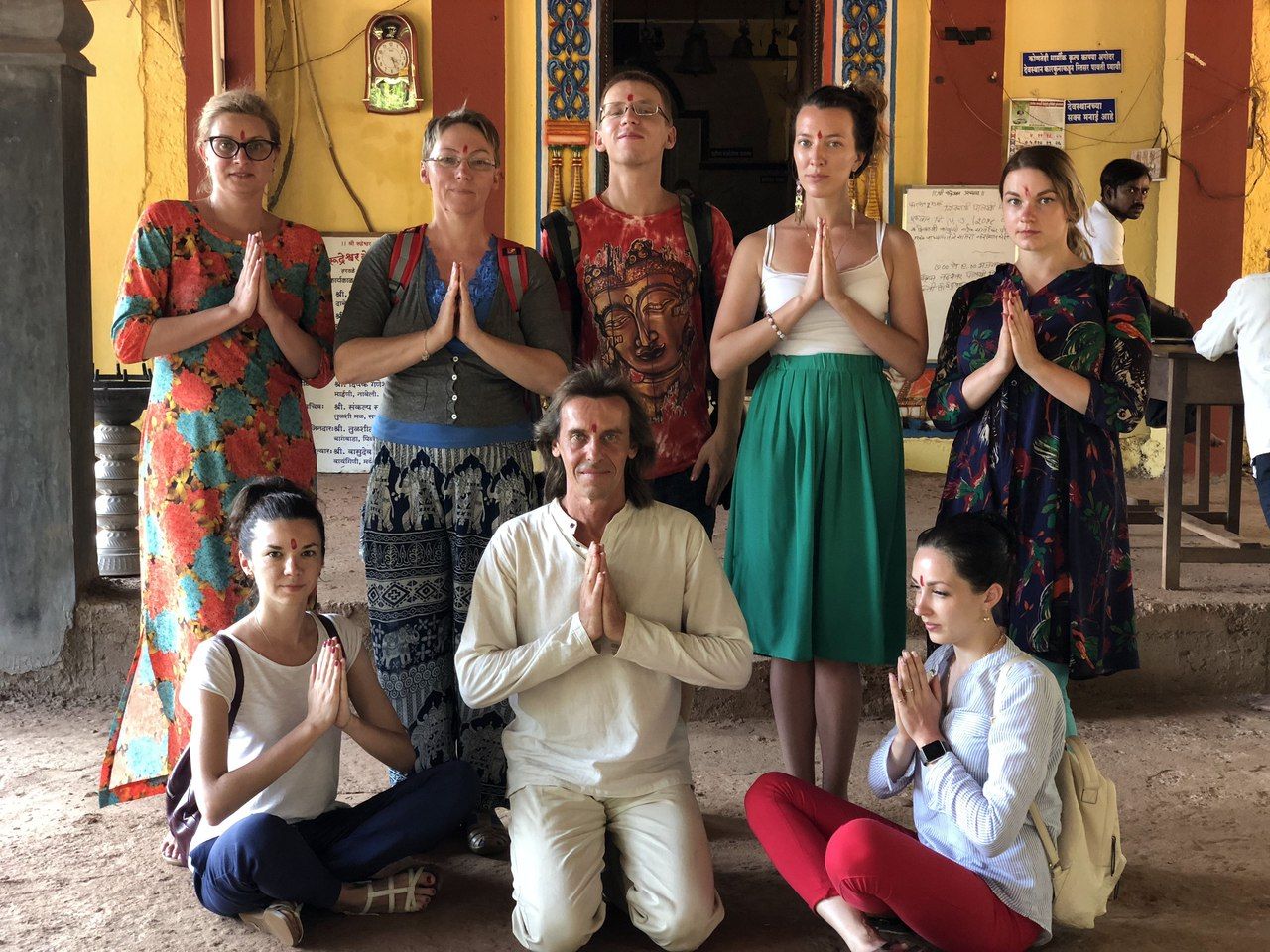
But the 10-day quest for Goa is not visually different from the usual exit.

A fishing trip to the Volga immediately explains that it will be possible to tell the peasants.

The dance camp attracts new acquaintances: this is also read only from the photo.
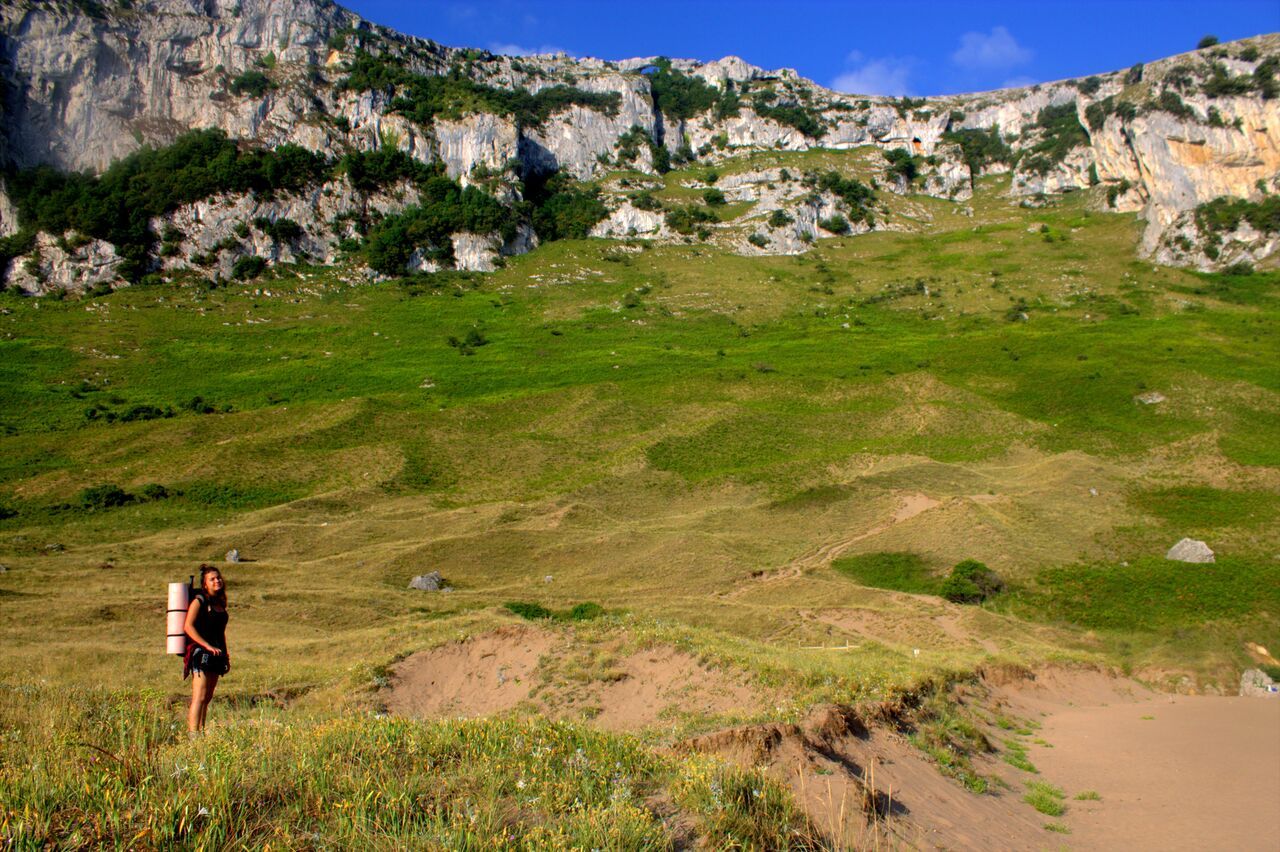
A walking tour of Portugal with lectures of English here is visually no different from the clip art about Portugal.
The result of the new form and the new presentation of the issue is:
In the summer all of Russia went to touch the water. Very increased the direction of the sap-tours. These are rowing boards, something like a simplified version of the kayak on which to stand. You can learn in a couple of hours, and then you can go on a board like a skateboard, small sea bays or go along the rivers. Croatia, Norway and Petersburg are waiting for you with such adventures.
In June, the popularity of yacht tours and informal yacht tours began, sometimes with some additional meaning. There are organizers who offer functional recreation for leveling skills. Since the boat has nothing special to do in the transitions, it offers classes like networking, time management, and so on. In general, any lectures are suitable, but due to the fact that usually the leaders want to go on yachts, a set of tours is appropriate. Yacht plus something is quite expensive, and such adventures greatly increase the average price of the market. On the other hand, here are tours on a yacht to the Crimea . Just a yacht + convertible, just a tour, no soft skills and networking - and they have been closed for a month in advance.
The difference is:
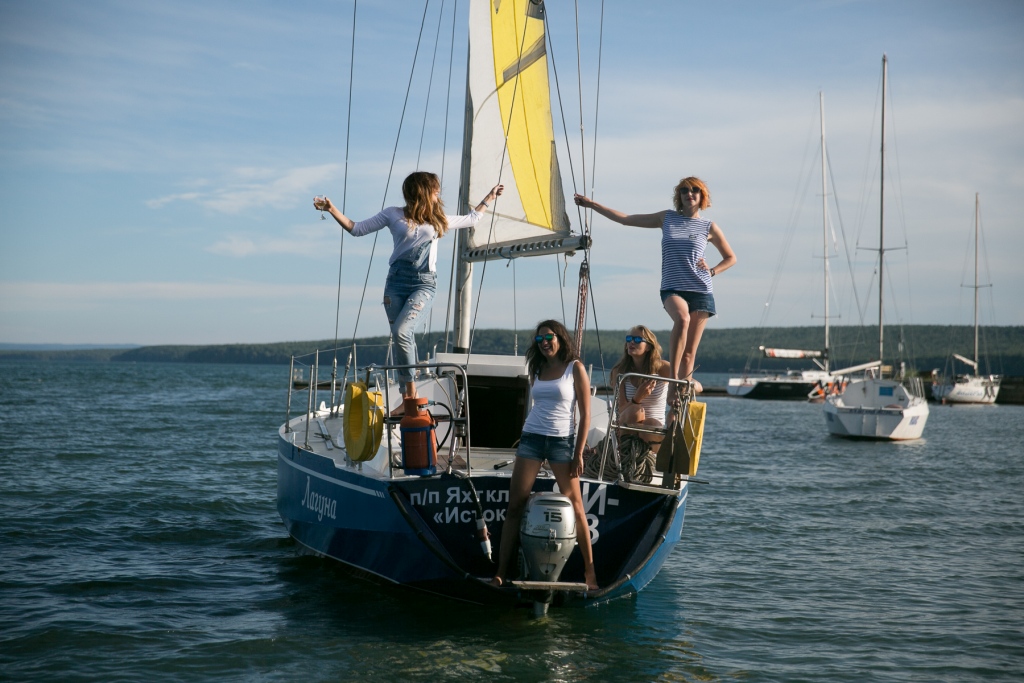
This is just a tour of Lake Baikal on yachts and jeeps , its value is what you see along the way. Or here is a tour with a yacht and a tent at Vyborg - also just a rest.
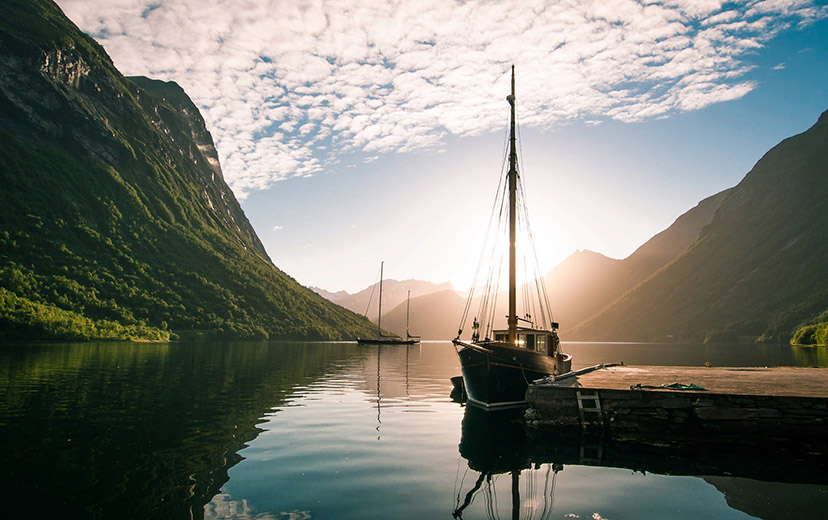
But yachts with fitness workouts every day and personal growth .
The mountains became popular again. Usually, the peak begins in February-March, but now, apparently, because of the heat, movement has begun again there. Moreover, it is easier to search for organizers thanks to our platform.
Russia is very popular. There is an unusual division into categories by age: 25–35 and 35–45 years. The first category flies to Europe, the typical representative is a young girl, free, above-average wealth, likes designer tours with tasting and photography of lavender fields. And the second category is those who have already seen a lot and want to rest something native and cozy. Globally, this coincides with the fact that there is a trend for the revival of Russia as a subject of tourism in general. Altai, Caucasus, Karelia is very popular: close to Moscow, you can go for a weekend. Slightly less - the countries of the former USSR. On our adventures, it also greatly affects.
Perhaps new adventures will open up new categories in the form of selection. I don't know yet. I can not say that now everything is searched perfectly, but we have already moved far, and all this more or less suits us. If you have thoughts or, maybe, you solved similar UX-problems, then write in a comment or email me at trip@tutu.ru, we are happy with any ideas. Well, just if you look at what we have on Tutu Adventures, and tell us what you like or not, it will help.
Our posts Tutu Adventures: Husky Park , unusual tourism , about yachts , about vaccinations , about going on tours , about travel insurance .
Here is the first form, it was designed for those who already know what they are looking for. As it turned out, we practically did not have such users:

')
Here we have added a free search field and our editorial collections. That didn't help much.
In parallel, we tested this form:

People still used the adventure catalog, and used the form only to find something they had already seen. On the other hand, we received statistics on its use and understood what people are looking for, when they do not understand what to look for. Since in the Russian market, such a problem, in principle, has not yet been solved, it was about what we need. Then we did a little research: we tested all this on people who are not aware of the project.
While postponing the hypothesis of adding tags for rework:

Then it turned out that people do not really understand what an adventure is. Need to see the range to look for. That is, this is a search that is possible only after viewing the catalog.
If a person asks what is adventure for him, he remembers only things already known. “I want to dive”, “And I want a gastrotur” - that is what is known. Almost everyone wanted to ride horses, but no one was looking for them.
Again, they removed everything that the users do not use, and began to collect statistics. With tens of thousands of hosts per day on the portal, this is a rather cynical but effective way to refine the UI.

The “hamburger” was opened not by type of adventure, but by the desired result:

And they made a full sadjest, which, depending on the person’s request, offers him several ways at once to search for adventures through the subject, region, organizer or selection (script):

Here were two important things at once. First, we had to look for “human” names for such things as “ethnotour” or “gastrotur”, because the terms too few people knew. Secondly, clustered themes of adventure to the main tasks in them. It is clear that this is a simplification, and some very unusual things will be left behind, and some will fall into several categories at once, but this is still the best idea of the workers.
At the same time, they tried to make an adviser like a telegram-bot for regular tours (only online), here are the details . It was assumed that if this interface works, then we can apply it to the adventure. But there the task is more understandable - emulation of communication with the manager of the travel agency, which many people lack on the site.
With adventure, we are closer to the usual search. The main thing is top-level ideas that can be done. In the tours, the question of fine-tuning, despite the fact that you know what you want and what you can. With top-level views, we rested in the cultural code. Here the words "relax" for a resident of Siberia often mean a beach holiday, and for a resident of Cyprus can mean mountains. And so on. It's like a story with a cup and a mug: when the values for the dictionary were updated, there were different versions in different regions. Somewhere mug - only metal. Somewhere a cup - only with a saucer. Somewhere a cup is in the kitchen, and a cup is in a sideboard. Somewhere they differ in thickness. At the same time, looking at the subject, we can quite uniquely determine what it is. With high-level search abstractions, the same effect had to be achieved.
We are in the process.
During development, small IT-tasks were crawling from different angles, which individually looked ridiculous, but together gave rise to an already complex system. For example, filter by price. That is, you need to bring everything to the same equivalent (apparently, ruble), taking into account the current exchange rate of different currencies (because adventures are in different countries). But to show the price in rubles is not very correct, because the courses can change every 15 minutes. Can be solved? Can. Simply? Yes, if you don’t know that there are hundreds of such questions.
As a result, the user's path now looks like this: he looks at an average of up to 15 adventures without sorting in order to understand what is possible in this world at all. Then he begins to clean up what he definitely does not want. And then oriented in the form and starts to play.
Another important discovery was that search works better not with parameters and descriptions, but with photos. It seems that for us a photo on Instagram is already a more natural result of travel than rest in itself.

A trip to the Day of the Dead in Mexico just needs pictures.

But the 10-day quest for Goa is not visually different from the usual exit.

A fishing trip to the Volga immediately explains that it will be possible to tell the peasants.

The dance camp attracts new acquaintances: this is also read only from the photo.

A walking tour of Portugal with lectures of English here is visually no different from the clip art about Portugal.
The result of the new form and the new presentation of the issue is:
- 22% of users find something using sorts.
- The most popular categories are to reboot, learn something new and hang out. The most popular subjects in general - excursion, on the sea, with children and mountain.
- The most unpopular ones are shopping, sports, May, ski and fitness.
- The percentage of failures with the launch of a new search decreased by 20%, the viewing depth increased by 8%, the time on the site remained unchanged.
What happens in the adventures now?
In the summer all of Russia went to touch the water. Very increased the direction of the sap-tours. These are rowing boards, something like a simplified version of the kayak on which to stand. You can learn in a couple of hours, and then you can go on a board like a skateboard, small sea bays or go along the rivers. Croatia, Norway and Petersburg are waiting for you with such adventures.
In June, the popularity of yacht tours and informal yacht tours began, sometimes with some additional meaning. There are organizers who offer functional recreation for leveling skills. Since the boat has nothing special to do in the transitions, it offers classes like networking, time management, and so on. In general, any lectures are suitable, but due to the fact that usually the leaders want to go on yachts, a set of tours is appropriate. Yacht plus something is quite expensive, and such adventures greatly increase the average price of the market. On the other hand, here are tours on a yacht to the Crimea . Just a yacht + convertible, just a tour, no soft skills and networking - and they have been closed for a month in advance.
The difference is:

This is just a tour of Lake Baikal on yachts and jeeps , its value is what you see along the way. Or here is a tour with a yacht and a tent at Vyborg - also just a rest.

But yachts with fitness workouts every day and personal growth .
The mountains became popular again. Usually, the peak begins in February-March, but now, apparently, because of the heat, movement has begun again there. Moreover, it is easier to search for organizers thanks to our platform.
Russia is very popular. There is an unusual division into categories by age: 25–35 and 35–45 years. The first category flies to Europe, the typical representative is a young girl, free, above-average wealth, likes designer tours with tasting and photography of lavender fields. And the second category is those who have already seen a lot and want to rest something native and cozy. Globally, this coincides with the fact that there is a trend for the revival of Russia as a subject of tourism in general. Altai, Caucasus, Karelia is very popular: close to Moscow, you can go for a weekend. Slightly less - the countries of the former USSR. On our adventures, it also greatly affects.
Perhaps new adventures will open up new categories in the form of selection. I don't know yet. I can not say that now everything is searched perfectly, but we have already moved far, and all this more or less suits us. If you have thoughts or, maybe, you solved similar UX-problems, then write in a comment or email me at trip@tutu.ru, we are happy with any ideas. Well, just if you look at what we have on Tutu Adventures, and tell us what you like or not, it will help.
Our posts Tutu Adventures: Husky Park , unusual tourism , about yachts , about vaccinations , about going on tours , about travel insurance .
Source: https://habr.com/ru/post/459502/
All Articles